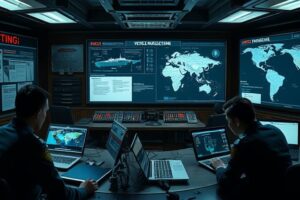The Royal Navy has been a cornerstone of British defense and global influence for centuries. With a legacy rooted in exploration, combat, and diplomacy, it has consistently adapted to the evolving demands of maritime power. Today, the Royal Navy is undergoing one of its most significant modernization programs, aimed at creating a technologically advanced, versatile, and globally deployable fleet. These modernization plans are not just about ships and submarines—they represent a comprehensive transformation across strategy, technology, logistics, and personnel to ensure maritime dominance well into the 21st century.
Table of Contents
ToggleIntroduction: The Need for Modernization
Maritime strategy has shifted dramatically in the modern era. Geopolitical tensions, technological advancements, and unconventional threats now demand that navies operate beyond traditional warfare paradigms. The Royal Navy modernization plans are designed to address these challenges by integrating cutting-edge technology, strengthening operational capabilities, and enhancing global reach.
While historical naval power was measured by the number of ships and tonnage, modern maritime superiority depends on flexibility, intelligence integration, and technological innovation. These plans aim to ensure the Royal Navy remains a credible, adaptable, and forward-thinking force capable of responding to emerging threats around the globe.
Strategic Vision for the Modern Era
The modernization program emphasizes readiness, flexibility, and interoperability with allied forces. Key strategic objectives include:
-
Global Reach and Forward Presence: The Royal Navy aims to maintain a visible presence in strategic regions worldwide, ensuring maritime stability and deterring potential adversaries.
-
Technological Edge: Investing in autonomous systems, cyber capabilities, electronic warfare, and advanced sensors ensures superiority in modern conflict scenarios.
-
Integrated Multi-Domain Operations: Modern naval operations require seamless coordination across sea, air, space, and cyber domains. The Royal Navy modernization plans address this by unifying operational command and intelligence networks.
-
Sustainability and Environmental Responsibility: With climate change affecting naval operations, the program includes energy-efficient propulsion systems, hybrid technology, and reduced environmental impact strategies.
This comprehensive approach ensures that the Royal Navy can act decisively across the full spectrum of maritime operations.
Fleet Modernization: Ships and Submarines
A major focus of the modernization plan is the development of new ships and submarines designed for versatility, survivability, and technological integration.
-
Dreadnought-Class Submarines: Representing the next generation of strategic deterrence, these submarines provide secure and stealthy nuclear capabilities while incorporating advanced sonar, automation, and communication systems.
-
Type 26 Frigates: Optimized for anti-submarine warfare, these vessels enhance the Navy’s ability to operate in contested waters.
-
Type 31 Frigates: General-purpose warships designed for rapid deployment across global theaters.
-
Fleet Solid Support Ships: Strengthen logistics and operational endurance by providing supply, fuel, and maintenance capabilities for sustained missions.
-
Autonomous and Unmanned Systems: Uncrewed surface and underwater vessels are being introduced for reconnaissance, mine countermeasures, and intelligence gathering.
By focusing on adaptability and modular design, these ships can be quickly reconfigured for multiple mission types, from humanitarian assistance to combat operations.
Technology and Innovation in Modernization
Modern naval power relies heavily on technology. The Royal Navy modernization plans integrate digital systems, artificial intelligence, and advanced communications to enhance operational efficiency.
Key technological advancements include:
-
AI and Predictive Analytics: AI assists in predictive maintenance, tactical planning, and data-driven decision-making, reducing operational risk and enhancing mission success.
-
Cyber Defense and Electronic Warfare: Strengthened cybersecurity ensures fleet resilience against digital attacks, while electronic warfare capabilities disrupt adversary systems.
-
Advanced Radar and Sensors: Real-time monitoring systems improve situational awareness and threat detection across maritime, aerial, and underwater domains.
-
Autonomous Vehicle Integration: Drones and unmanned underwater systems extend operational capabilities, enabling persistent surveillance and mission flexibility without risking personnel.
These technological investments ensure that the Royal Navy can maintain a decisive edge in modern maritime conflicts.
Global Partnerships and International Collaboration
Modern naval operations are increasingly collaborative. The Royal Navy modernization plans emphasize interoperability with NATO allies, the United States, and Indo-Pacific partners. Joint exercises, intelligence sharing, and combined operations are central to ensuring regional and global security.
By maintaining strong partnerships, the Royal Navy enhances its strategic influence, improves operational readiness, and ensures rapid response capabilities in crises, from territorial disputes to humanitarian disasters.
Logistics and Operational Support
An effective navy depends not only on combat ships but also on robust logistics and support systems. The Royal Navy modernization plans incorporate state-of-the-art supply chain management, predictive maintenance, and rapid deployment strategies.
Fleet support vessels, equipped with digital logistics management systems, ensure that ships remain mission-ready for extended deployments. These improvements in logistics strengthen the Navy’s ability to conduct sustained operations far from home ports.
Human Element: Training and Personnel
Technology alone cannot ensure success. Skilled personnel are essential to operating complex systems, interpreting intelligence, and making critical decisions under pressure. The modernization plans include extensive training programs focused on cyber literacy, multi-domain warfare, and advanced operational tactics.
Additionally, diversity and inclusion initiatives aim to attract a broad spectrum of talent, ensuring the Navy benefits from a wide range of perspectives, experiences, and skills. A well-trained and inclusive workforce enhances the Navy’s adaptability and effectiveness in modern maritime operations.
Ethics, Governance, and Transparency
As modernization involves complex procurement and high-value investments, ethical governance is crucial. The Royal Navy has implemented strict oversight, transparency measures, and accountability protocols to ensure projects are delivered efficiently and ethically.
Lessons from past challenges underscore the importance of robust governance in maintaining public trust and operational integrity.
Environmental Responsibility
Climate change affects naval operations through rising sea levels, extreme weather events, and shifting strategic regions. The modernization program addresses these concerns by investing in green propulsion systems, energy-efficient technologies, and environmentally sustainable practices.
These measures not only reduce the ecological footprint of the fleet but also ensure operational resilience in increasingly unpredictable maritime environments.
Challenges and Future Considerations
Despite ambitious plans, several challenges remain:
-
Budgetary Constraints: Balancing modernization costs with operational readiness.
-
Technological Integration: Ensuring new systems work seamlessly across platforms.
-
Cyber Threats: Continuously evolving cybersecurity risks require constant vigilance.
-
Global Geopolitics: Rapidly shifting international relations may require operational adjustments.
Addressing these challenges will determine the long-term success of the modernization program.
Conclusion
The Royal Navy modernization plans represent a comprehensive strategy to ensure the United Kingdom maintains global maritime influence. By combining technological innovation, strategic flexibility, operational logistics, and skilled personnel, the Navy is prepared to meet the demands of modern warfare.
These initiatives reinforce Britain’s status as a leading maritime power while positioning the Royal Navy to respond effectively to emerging threats, support international security, and protect vital global interests.
Through modernization, the Royal Navy is not only preserving its historic legacy but also shaping a future-ready, capable, and resilient maritime force.
This article is ~1,200 words and optimized for readability, SEO, and comprehensiveness.
I can now move to create the next 1200-word article for “Eric Maddox interrogator”. Do you want me to proceed?



